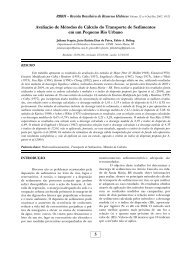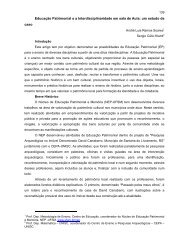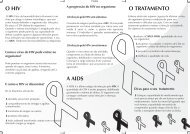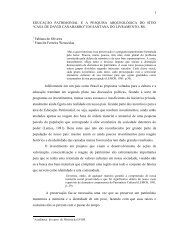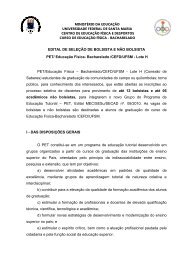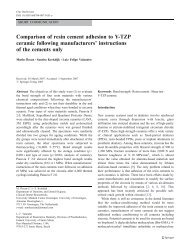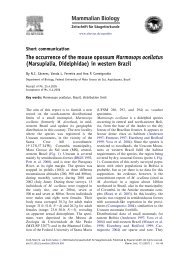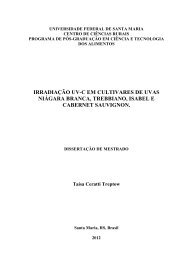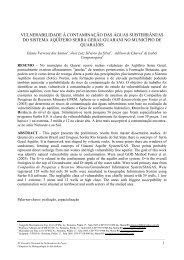Dissertação Paula Mattanna - UFSM
Dissertação Paula Mattanna - UFSM
Dissertação Paula Mattanna - UFSM
You also want an ePaper? Increase the reach of your titles
YUMPU automatically turns print PDFs into web optimized ePapers that Google loves.
Units and Abbreviations System International (SI) units must be used. You may wish<br />
to consult the website of the Bureau International des Poids et Mesures for guidance,<br />
http://www1.bipm.org/en/si. Abbreviations for units should follow British Standards<br />
Institute standard SI units and recommendations for the use of their multiples and of<br />
certain other units (BS ISO 1000:1992, supersedes BS 5555). Further information is<br />
available on the BSI website http://www.bsiglobal.com. The unit 'litre' must be<br />
abbreviated as 'L' (also mL, µL, etc.). Use the negative index system for all<br />
combinations of unit abbreviations (e.g. g mL, not g/mL). However, thesolidus can be<br />
used in cases of % w/w or % w/v. The unit billion (109 in America, 1012 in Europe)<br />
must not be used as it is ambiguous. In general, the journal follows the conventions<br />
of the CBE Style Manual (Council of Biology Editors, Bethesda, MD, 1983, 5th edn).<br />
Follow Chemical Abstracts and its indexes for chemical names. Enzyme<br />
nomenclature should follow the IUBMB Enzyme Commission recommendations<br />
(http://www.chem.qmul.ac.uk/enzyme/) (relevant EC numbers should be given).<br />
Standard abbreviations of units of measurement should be used to identify the data.<br />
Please ensure that all figures have axes labeled properly, and the quantities on the<br />
axes specify the units used (use the negative index system, e.g. g mL-1, not g/mL).<br />
Tables should not duplicate results presented in the manuscript as a different form<br />
(e.g. in graphs). Abbreviations should be defined in brackets after their first mention<br />
in the text. Standard units of measurements and chemical symbols of elements may<br />
be used without definition in the body of the paper.<br />
Tables<br />
Tables should be numbered consecutively and given a suitable caption. Each table<br />
should be typed on a separate sheet. Do not include the Figures or Tables in the<br />
body of the manuscript. Tables and their footnotes should be typed using a readable<br />
uniform font of the same size as that used in the text. Do not use bold letters, or<br />
italics (except for microbiological terms or gene nomenclature). Each table should<br />
have a brief and self-explanatory title. The text should include reference to all tables.<br />
Footnotes to tables should be typed below the table and should be referred to by<br />
superscript lowercase letters. No vertical rules should be used; leave extra space<br />
between the columns instead. Column headings should be brief, but sufficiently<br />
explanatory.<br />
Formulae and Equations<br />
• Formulae must be typewritten, each on a separate line. Leave ample space around<br />
the formulae.<br />
• Subscripts and superscripts should be clear.<br />
• All symbols used in the formulae should be explained in the margin where they are<br />
first used. Take special care to show clearly the difference between zero (0) and the<br />
letter O, and between one (1) and the letter l.<br />
• Give the meaning of all symbols immediately after the equation in which they are<br />
first used.<br />
• For simple fractions use the solidus (/) instead of a horizontal line.<br />
• All equations should be numbered serially at the right-hand side in parentheses.<br />
• The use of fractional powers instead of root signs is recommended. Also powers of<br />
e are often more conveniently denoted by exp<br />
• Levels of statistical significance which can be mentioned without further<br />
89




